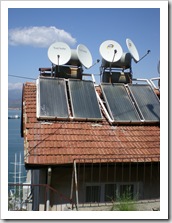 Throughout our travels on foot and via bus across Turkey, I have noticed some common cultural themes that are very different to what we are used to in the west.
Throughout our travels on foot and via bus across Turkey, I have noticed some common cultural themes that are very different to what we are used to in the west.
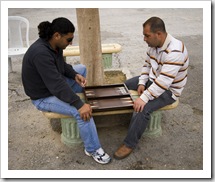 Water Heaters: The water heating system consists of two metal barrels stacked on the roof which are attached to solar heating panels, the water is stored and heated and then transferred back into the homes. This has been interesting in our accommodation because it takes a while to get the hot water but when you do, it is scalding and hard to find a comfortable temperature. There are often many of these barrel systems on one roof to accommodate entire apartment buildings. This picture is also showing satellite dishes for TV.
Water Heaters: The water heating system consists of two metal barrels stacked on the roof which are attached to solar heating panels, the water is stored and heated and then transferred back into the homes. This has been interesting in our accommodation because it takes a while to get the hot water but when you do, it is scalding and hard to find a comfortable temperature. There are often many of these barrel systems on one roof to accommodate entire apartment buildings. This picture is also showing satellite dishes for TV.
Backgammon: When we were in the Bahamas last year, all of the older men sat on the corners and played dominos all afternoon. Here, the pensioners sit around and play backgammon (although much more quietly than the Bahamians played dominos).
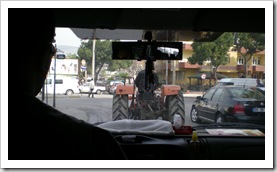 Driving: We could write an entire essay on this. The short description is there are no rules. Four grown men on one scooter (none with helmets), plenty of little kids in the back and front seats of cars, none of which are in baby seats or seatbelts. There are very few painted road lanes, you just go for it and many times if there is a lane, a car will straddle it and consider it a third lane. Huge buses passing smaller buses, work trucks or cars on a two lane road with oncoming traffic approaching. Tractors are often seen driving with large trailers through very narrow streets in the middle of a bustling town. The photo shows a tractor holding us up while on a bus trip in Selcuk. If you are walking on the side of the street, you had better keep your ears open and move out of the way because cars will not stop and wait for you like they do in the states. Honking and cutting-off merging cars are very common. It is always an adventure and surprisingly we have not seen any accidents.
Driving: We could write an entire essay on this. The short description is there are no rules. Four grown men on one scooter (none with helmets), plenty of little kids in the back and front seats of cars, none of which are in baby seats or seatbelts. There are very few painted road lanes, you just go for it and many times if there is a lane, a car will straddle it and consider it a third lane. Huge buses passing smaller buses, work trucks or cars on a two lane road with oncoming traffic approaching. Tractors are often seen driving with large trailers through very narrow streets in the middle of a bustling town. The photo shows a tractor holding us up while on a bus trip in Selcuk. If you are walking on the side of the street, you had better keep your ears open and move out of the way because cars will not stop and wait for you like they do in the states. Honking and cutting-off merging cars are very common. It is always an adventure and surprisingly we have not seen any accidents.
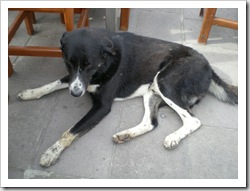 Breakfast: The breakfasts seem to always be included with our pansiyons and consist of the same things: sliced tomato, sliced cucumber, olives, fresh bread, cheese (usually like a feta), and sometimes a hard-boiled egg or a strange processed meat that tastes like bologna. The locals like to snack on what looks like a giant round pretzel covered with sesame seeds. I’m not sure what they are called, but they’re sold on every street corner in the morning. We tried a piece of one that the owner of our pansiyon offered us and found it to be very dry.
Breakfast: The breakfasts seem to always be included with our pansiyons and consist of the same things: sliced tomato, sliced cucumber, olives, fresh bread, cheese (usually like a feta), and sometimes a hard-boiled egg or a strange processed meat that tastes like bologna. The locals like to snack on what looks like a giant round pretzel covered with sesame seeds. I’m not sure what they are called, but they’re sold on every street corner in the morning. We tried a piece of one that the owner of our pansiyon offered us and found it to be very dry.
Animals: Cows, goats, sheep, chickens, cats and dogs. Many of the homes in the small towns between larger cities will have a cow, goat or sometimes a donkey tied up in front of their dwelling. We have even seen goats tied up on the median strips of busier roads. Also in the small towns there are many sheep and goat herders, standing guard of their flock to make sure they don’t venture onto the busy roads. Many local dogs and cats roam the streets, you can tell the local dogs versus stray dogs because they have been tagged in their ear (indicating they have been neutered). The cats tend to look a bit more scruffy. Chickens are seen everywhere scratching the dirt. It seems the dogs, cats and chickens don’t bother each other.
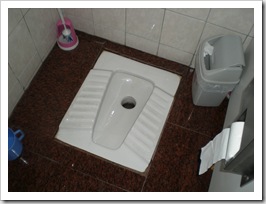 WC: Otherwise known as restrooms, toilets or bathrooms. The public toilets crack me up. You must pay to use them by giving your lira to an attendant who sits in a glassed-in box (prices range from 0.50-0.75 YTL). The attendant will then unlock the turnstile and you may enter (like entering a theme park). If you are lucky, you will find what we consider a ‘normal’ toilet but at times there is just a hole in the ground with two spots where you put your feet (but it is tiled). You must stand back when flushing this type of toilet because water shoots out everywhere. I was clued in by another Aussie passenger on our bus to check all of the stalls in the WC because sometimes there will be just a couple of ‘normal’ toilets at the end of the row. Learn as you go.
WC: Otherwise known as restrooms, toilets or bathrooms. The public toilets crack me up. You must pay to use them by giving your lira to an attendant who sits in a glassed-in box (prices range from 0.50-0.75 YTL). The attendant will then unlock the turnstile and you may enter (like entering a theme park). If you are lucky, you will find what we consider a ‘normal’ toilet but at times there is just a hole in the ground with two spots where you put your feet (but it is tiled). You must stand back when flushing this type of toilet because water shoots out everywhere. I was clued in by another Aussie passenger on our bus to check all of the stalls in the WC because sometimes there will be just a couple of ‘normal’ toilets at the end of the row. Learn as you go.
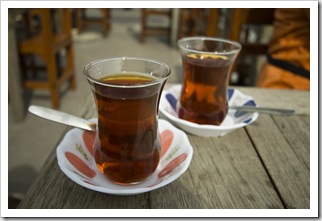 Tea: Chai is consumed all day long. Large groups of men sit around smoking and drinking chai out of small clear glasses with a saucer. You will often see a man or boy walking down the street with a platter full of cups of chai delivering them to the shop keepers or street vendors. We have enjoyed drinking the chai as well and for 0.50-1 YTL, you can’t beat it. One shop keeper told us it is common for Turks to drink up to 30 cups of chai per day.
Tea: Chai is consumed all day long. Large groups of men sit around smoking and drinking chai out of small clear glasses with a saucer. You will often see a man or boy walking down the street with a platter full of cups of chai delivering them to the shop keepers or street vendors. We have enjoyed drinking the chai as well and for 0.50-1 YTL, you can’t beat it. One shop keeper told us it is common for Turks to drink up to 30 cups of chai per day.
Sunflower Seeds: They are massive! The sunflower seeds are sold in bulk by street vendors or in the corner markets along with many other nuts including almonds, dried garbanzo beans, hazelnuts, pistachios, and peanuts. I had to buy some seeds to give them a try and they were pretty tasty. Dried apricots and dried figs are also very common and the figs are delicious!
Mosques: We are often woken in the early AM (5AM-6AM) by the morning prayers of each town. There are many mosques in the towns, easy to identify because they usually have a large domed roof and next to it a tower that is encircled with speakers. We think that the same prayers get broadcast across all of the mosques in a given town simultaneously because it’s very loud everywhere (although we don’t know the language so it is hard to confirm). The mosques also announce prayers throughout the afternoon and usually late evening around 8:30PM or 9PM, we think there are five per day.
This entry was posted on Friday, April 24th, 2009 at 7:35 PM and is filed under Turkey. You can follow any responses to this entry through the RSS 2.0 feed. Both comments and pings are currently closed.

did you think that was me on my tractor
May 4th, 2009 at 4:26 AM
Enjoyed the “cultural” observations. What a great way to start the day with their “typical” breakfasts … and the sunflower seeds and Chai sound lovely, too. The toilets are like those in Taiwan … and the same thing, sometimes a “western style” at the very end. Interesting isn’t it? Middle East similar to Far East.
Love and blessings!
May 6th, 2009 at 2:15 AM